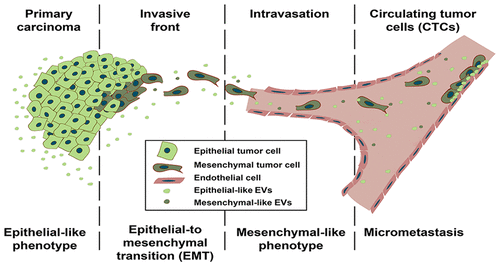当前位置:
X-MOL 学术
›
J. Proteome Res.
›
论文详情
Our official English website, www.x-mol.net, welcomes your feedback! (Note: you will need to create a separate account there.)
Proteomic Characterization of Epithelial-Like Extracellular Vesicles in Advanced Endometrial Cancer.
Journal of Proteome Research ( IF 4.4 ) Pub Date : 2019-01-11 , DOI: 10.1021/acs.jproteome.8b00750 Javier Mariscal 1 , Patricia Fernandez-Puente 2 , Valentina Calamia 2 , Alicia Abalo 1 , Maria Santacana 3 , Xavier Matias-Guiu 3 , Rafael Lopez-Lopez 1 , Antonio Gil-Moreno 4 , Lorena Alonso-Alconada 1 , Miguel Abal 1
Journal of Proteome Research ( IF 4.4 ) Pub Date : 2019-01-11 , DOI: 10.1021/acs.jproteome.8b00750 Javier Mariscal 1 , Patricia Fernandez-Puente 2 , Valentina Calamia 2 , Alicia Abalo 1 , Maria Santacana 3 , Xavier Matias-Guiu 3 , Rafael Lopez-Lopez 1 , Antonio Gil-Moreno 4 , Lorena Alonso-Alconada 1 , Miguel Abal 1
Affiliation

|
Endometrial cancer (EC) is the most frequent gynecological cancer. Tumor dissemination affecting ∼20% of EC patients is characterized at the primary carcinoma by epithelial-to-mesenchymal transition (EMT) associated with myometrial infiltration. At distant sites, the interaction of circulating tumor cells (CTCs) with the microenvironment is crucial for metastatic colonization, with a participation of the extracellular vesicles (EVs). We comprehensively approached these primary and secondary sites to study the impact of tumor EVs on the metastatic efficiency of CTCs in EC. Tumor EVs in circulation reproduce the epithelial phenotype predominant in the primary carcinoma, whereas CTCs are characterized by an EMT phenotype. We modeled this EMT-related clinical scenario in the Hec1A endometrial cell line and characterized the epithelial-like EVs in circulation by SILAC proteome analysis. The identification of proteins involved in cell-cell and cell-matrix interaction and binding, together with in vitro evidence of an improved adhesion of CTC to a functionalized endothelium, suggests a contribution of the epithelial-like EVs in the homing of CTCs at metastatic sites. Accordingly, adhesion protein LGALS3BP was found to be significantly enriched in circulating EVs from a cohort of EC patients with a high risk of recurrence by targeted proteomics (multiple reaction monitoring), highlighting its potential in liquid biopsy in EC.
中文翻译:

晚期子宫内膜癌中上皮样细胞外囊泡的蛋白质组学表征。
子宫内膜癌(EC)是最常见的妇科癌症。在约20%的EC患者中,肿瘤扩散的特征在于与子宫肌层浸润相关的上皮间质转化(EMT)在原发癌中。在远处,循环肿瘤细胞(CTC)与微环境的相互作用对于转移定居至关重要,细胞外囊泡(EV)参与其中。我们全面地接近了这些主要和次要部位,以研究肿瘤电动汽车对EC中CTC转移效率的影响。循环中的肿瘤电动汽车复制在原发癌中占主导地位的上皮表型,而CTC的特征在于EMT表型。我们在Hec1A子宫内膜细胞系中模拟了与EMT相关的临床情况,并通过SILAC蛋白质组分析对循环中的上皮样EV进行了表征。鉴定参与细胞-细胞和细胞-基质相互作用和结合的蛋白质,以及体外证据表明CTC与功能化内皮细胞的粘附性提高,表明上皮样EV对CTC在转移部位的归巢有贡献。因此,通过靶向蛋白质组学(多反应监测),发现粘附蛋白LGALS3BP在循环风险较高的具有高复发风险的EC患者队列中被发现显着富集,突显了其在EC液体活检中的潜力。连同CTC与功能化内皮细胞粘附性改善的体外证据表明,上皮样EV对转移部位CTC归巢的贡献。因此,通过靶向蛋白质组学(多反应监测),发现粘附蛋白LGALS3BP在循环风险较高的具有高复发风险的EC患者队列中被发现显着富集,突显了其在EC液体活检中的潜力。连同CTC与功能化内皮细胞粘附性改善的体外证据表明,上皮样EV对转移部位CTC归巢的贡献。因此,通过靶向蛋白质组学(多反应监测),发现粘附蛋白LGALS3BP在循环风险较高的具有高复发风险的EC患者队列中被发现显着富集,突显了其在EC液体活检中的潜力。
更新日期:2019-02-07
中文翻译:

晚期子宫内膜癌中上皮样细胞外囊泡的蛋白质组学表征。
子宫内膜癌(EC)是最常见的妇科癌症。在约20%的EC患者中,肿瘤扩散的特征在于与子宫肌层浸润相关的上皮间质转化(EMT)在原发癌中。在远处,循环肿瘤细胞(CTC)与微环境的相互作用对于转移定居至关重要,细胞外囊泡(EV)参与其中。我们全面地接近了这些主要和次要部位,以研究肿瘤电动汽车对EC中CTC转移效率的影响。循环中的肿瘤电动汽车复制在原发癌中占主导地位的上皮表型,而CTC的特征在于EMT表型。我们在Hec1A子宫内膜细胞系中模拟了与EMT相关的临床情况,并通过SILAC蛋白质组分析对循环中的上皮样EV进行了表征。鉴定参与细胞-细胞和细胞-基质相互作用和结合的蛋白质,以及体外证据表明CTC与功能化内皮细胞的粘附性提高,表明上皮样EV对CTC在转移部位的归巢有贡献。因此,通过靶向蛋白质组学(多反应监测),发现粘附蛋白LGALS3BP在循环风险较高的具有高复发风险的EC患者队列中被发现显着富集,突显了其在EC液体活检中的潜力。连同CTC与功能化内皮细胞粘附性改善的体外证据表明,上皮样EV对转移部位CTC归巢的贡献。因此,通过靶向蛋白质组学(多反应监测),发现粘附蛋白LGALS3BP在循环风险较高的具有高复发风险的EC患者队列中被发现显着富集,突显了其在EC液体活检中的潜力。连同CTC与功能化内皮细胞粘附性改善的体外证据表明,上皮样EV对转移部位CTC归巢的贡献。因此,通过靶向蛋白质组学(多反应监测),发现粘附蛋白LGALS3BP在循环风险较高的具有高复发风险的EC患者队列中被发现显着富集,突显了其在EC液体活检中的潜力。


























 京公网安备 11010802027423号
京公网安备 11010802027423号